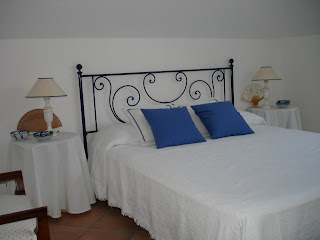It's a 1920 Villa, overlooking the Serapo and Fontania beaches, at walking distance from the seaside.
This is the house where my grand-grandmother's family spent vacation time, long before I was born. Since then, several generations have enjoyed its peace, the awe-inspiring view of the sea, the smell of flowers that the wind carries from the garden.
Each generation has given its touch to the Villa, that has been frequently renowated (last time just 2 years ago) and equipped with every modern utility.
The house consists of three levels. The first is where my uncle and his family spend their holidays. The second floor is where we go and relax when the rythm of Roman life has us in need of a break. The third level is the penthouse that we rent to our guests (see pictures below).
The penthouse has an area of approximately 70-75 square meters (750-800 sq.ft.).
It is fully air-conditioned, and consists of a spacious living room, with a view on the sea, and a dinner table where one can enjoy breakfast or dinner.
The kitchen is fully equipped with everything a family needs to cook and serve meals, and a brand new dishwasher.Also a washing machine is ready for our guests.
There are two double bedrooms. One has a large iron bed, the second one has a double sofa-bed.
The bathroom is equipped with shower.
Our garden has been recently renovated, leaving the older trees (including two one-century-old palmtrees) and adding many new local and exotic plants. There are lemon trees, several kinds of palms, and even an avocado tree (the only one that we heard of that gives fruits in Italy!).
You can see a selection of pictures at the end of this page.
If you need more detailed information, just contact us:
Email : quetzalkoala@inwind.it
enzo_micalizzi@alice.it
Phone : 0039-331-7703753
0039-06-3340357
0039-335-1224027

A view from the Villa's garden

A detail of the garden
Another corner of the garden

Granny's palmtree

The living room

The dinner table
The kitchen
A closer view of the kitchen
The main bedroom
A detail of the second bedroom
The bathroom
Another detail of the bathroom




















































